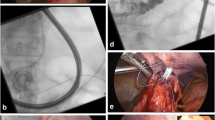Abstract
We describe our experience with fluoroscopically guided percutaneous gastrostomy, assessing in particular the functional performance of inserted tubes. We also examine the ability of radiological investigations to detect intraperitoneal gastrostomy leakage after the procedure. A functioning gastrostomy tube was established and maintained for as long as was required in 34 (89.5%) of 38 patients referred during a 21-month period. This necessitated further gastrostomy tube placements in 13 patients. On average, inserted gastrostomy tubes functioned for 10.75 weeks and during the review period a total of 34 malfunctioning tubes required replacement or removal. This was most commonly due to tube dislodgement, blockage, or intraperitoneal leakage. We found increasing pneumoperitoneum on sequential postprocedure erect chest films a reliable sign in the diagnosis of the latter complication. In conclusion, while we have been disappointed with aspects of individual tube function, our satisfactory overall functional success rate indicates that percutaneous gastrostomy is an effective method for establishing and maintaining enteral feeding. We also propose a protocol for the management of suspected intraperitoneal leakage based on the findings on postprocedure erect chest films.
Similar content being viewed by others
References
Ho CS. Percutaneous gastrostomy for jejunal feeding. Radiology 1983;149:595–596
Tao HH, Gillies RR. Percutaneous feeding gastrostomy. AJR 1983;141;793–794
Wills JS, Oglesby JT. Percutaneous gastrostomy. Radiology 1983;149:449–453
Ho CS, Gray RR, Goldfinger M, Rosen IE, McPherson R. Percutaneous gastrostomy for enteral feeding. Radiology 1985;156:349–351
Halkier BK, Ho CS, Yee ACN. Percutaneous feeding gastrostomy with the Seldinger technique: review of 252 patients. Radiology 1989;171:359–361
Saini S, Mueller PR, Gaa J, et al. Percutaneous gastrostomy with gastropexy: experience in 125 patients. AJR 1990;154:1003–1006
Ho CS, Yeung EY. Percutaneous gastrostomy and transgastric jejunostomy. AJR 1992;158:251–257
O Keeffe F, Carrasco CH, Charnsangavej C, Richli R, Wallace S, Friedman RS. Percutaneous drainage and feeding gastrostomies in 100 patients. Radiology 1989;172:341–343
Moran BJ, Taylor MB, Johnson CD. Percutaneous endoscopic gastrostomy. Br J Surg 1990;77:858–862
Kutcher W, Cohen LB, Leonhardt C, Earhlich L. Impaired gastric emptying following percutaneous endoscopic gastrostomy (PEG). Gastroenterology 1989;5:686
Gray RR, St Louis EL, Grosman H. Modified catheter for percutaneous gastrojejunostomy. Radiology 1989;173:276–278
Chung RS, Schertzer M. Pathogenesis of complications of percutaneous endoscopic gastrostomy: a lesson in surgical principles. Am Surg 1990;56:134–137
Gottfield EB, Plumser AB, Clair MR. Pneumoperitoneum following percutaneous endoscopic gastrostomy. Gastrointest Endosc 1986;32:397–399
Wojtowycz MM, Arata JA, Micklos TJ, Miller FJ. CT findings after uncomplicated percutaneous gastrostomy. AJR 1988;151:307–309
Author information
Authors and Affiliations
Rights and permissions
About this article
Cite this article
McLoughlin, R.F., Gibney, R.G. Fluoroscopically guided percutaneous gastrostomy: Tube function and malfunction. Abdom Imaging 19, 195–200 (1994). https://doi.org/10.1007/BF00203505
Received:
Accepted:
Issue Date:
DOI: https://doi.org/10.1007/BF00203505




